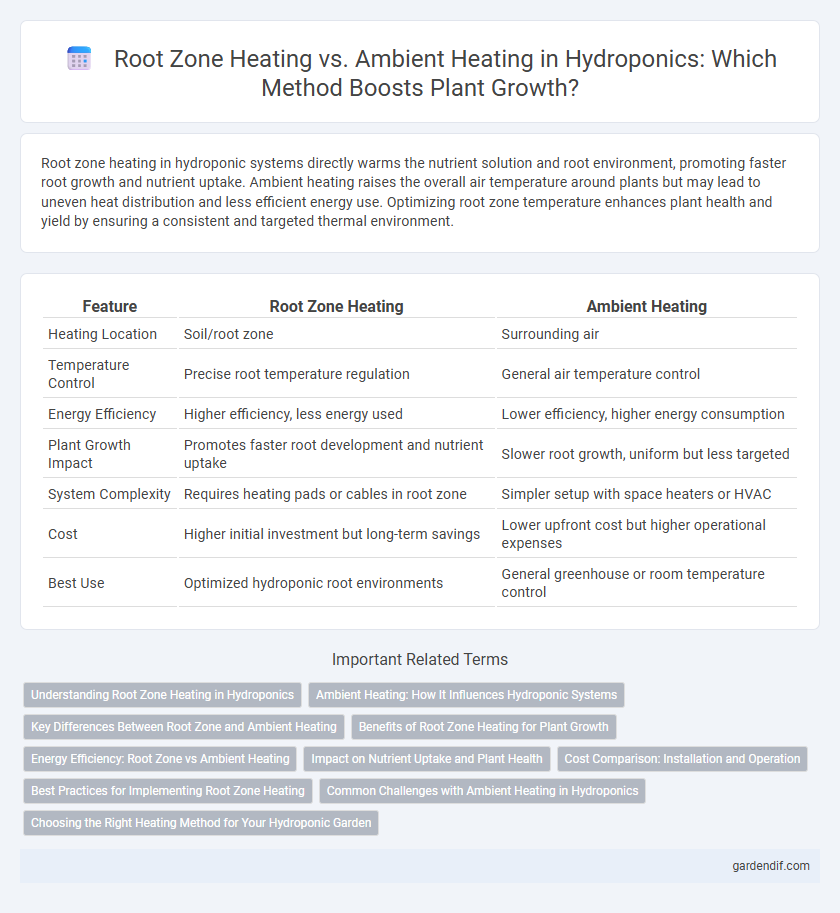
Root Zone Heating vs Ambient Heating Illustration
Root zone heating in hydroponic systems directly warms the nutrient solution and root environment, promoting faster root growth and nutrient uptake. Ambient heating raises the overall air temperature around plants but may lead to uneven heat distribution and less efficient energy use. Optimizing root zone temperature enhances plant health and yield by ensuring a consistent and targeted thermal environment.
Table of Comparison
| Feature | Root Zone Heating | Ambient Heating |
|---|---|---|
| Heating Location | Soil/root zone | Surrounding air |
| Temperature Control | Precise root temperature regulation | General air temperature control |
| Energy Efficiency | Higher efficiency, less energy used | Lower efficiency, higher energy consumption |
| Plant Growth Impact | Promotes faster root development and nutrient uptake | Slower root growth, uniform but less targeted |
| System Complexity | Requires heating pads or cables in root zone | Simpler setup with space heaters or HVAC |
| Cost | Higher initial investment but long-term savings | Lower upfront cost but higher operational expenses |
| Best Use | Optimized hydroponic root environments | General greenhouse or room temperature control |
Understanding Root Zone Heating in Hydroponics
Root zone heating in hydroponics directly warms the nutrient solution around plant roots, enhancing nutrient uptake and promoting faster growth compared to ambient heating, which raises the overall air temperature without targeting root-specific conditions. Maintaining optimal root zone temperatures, typically between 65degF and 75degF (18degC to 24degC), prevents stress and fosters efficient metabolic processes essential for healthy plant development. This targeted approach improves oxygen absorption and reduces the risk of root diseases, resulting in more uniform and vigorous crop yields.
Ambient Heating: How It Influences Hydroponic Systems
Ambient heating in hydroponic systems raises the overall temperature of the growing environment, impacting plant growth by promoting faster nutrient uptake and metabolism. Unlike root zone heating, which targets just the root area, ambient heating ensures uniform temperature distribution that can enhance photosynthesis and prevent temperature stress. Maintaining optimal ambient temperatures between 20-25degC supports consistent plant development and reduces risks of diseases caused by cold or fluctuating temperatures.
Key Differences Between Root Zone and Ambient Heating
Root zone heating directly warms the nutrient solution or substrate, optimizing root metabolism and nutrient uptake for faster plant growth and improved crop yields. Ambient heating raises the air temperature in the grow environment, which can influence overall plant development but may not efficiently target root temperature or maximize energy use. The key differences lie in energy efficiency, target temperature control, and the resulting impact on root health and growth rate.
Benefits of Root Zone Heating for Plant Growth
Root zone heating directly warms the root environment, enhancing nutrient uptake and accelerating metabolic processes for faster plant growth. Maintaining optimal root temperatures improves water absorption efficiency and reduces stress caused by cold soil conditions. This targeted heating approach results in stronger root development, increased yield, and better overall plant health compared to ambient heating methods.
Energy Efficiency: Root Zone vs Ambient Heating
Root zone heating directly warms the nutrient solution and plant roots, reducing energy loss compared to ambient heating, which heats the entire grow room air. This targeted method improves energy efficiency by maintaining optimal root temperatures with lower overall energy consumption. Studies show root zone heating can reduce energy usage by up to 30% in hydroponic systems compared to ambient room heating.
Impact on Nutrient Uptake and Plant Health
Root zone heating in hydroponic systems directly regulates the temperature around plant roots, enhancing nutrient absorption efficiency and promoting robust root development. Ambient heating raises the overall greenhouse temperature but can lead to uneven root zone temperatures, potentially causing nutrient uptake imbalances and increased plant stress. Optimal root zone temperature control improves enzymatic activity in roots, resulting in better nutrient solubility and healthier, faster-growing plants compared to relying solely on ambient heating.
Cost Comparison: Installation and Operation
Root zone heating in hydroponic systems typically incurs higher initial installation costs due to specialized equipment like heating mats or cables, but it offers more efficient energy use by directly warming the plant roots. Ambient heating requires less upfront investment with standard heaters but results in higher operational expenses as it heats the entire growing area, leading to energy waste. Over time, root zone heating reduces energy consumption and operational costs, making it a cost-effective choice for commercial hydroponic growers focused on sustainability and yield optimization.
Best Practices for Implementing Root Zone Heating
Root zone heating in hydroponic systems enhances nutrient uptake and accelerates plant growth by maintaining optimal temperatures directly at the root interface, typically between 20-24degC. Best practices include using thermostatically controlled heating mats or cables installed beneath the growing medium, ensuring consistent temperature without overheating, and monitoring soil moisture to prevent root stress or disease. Compared to ambient heating, targeted root zone heating reduces energy consumption and environmental fluctuations, leading to more stable root zone conditions and improved crop yields.
Common Challenges with Ambient Heating in Hydroponics
Ambient heating in hydroponics often results in uneven temperature distribution, leading to inconsistent root zone conditions that can stress plants and reduce nutrient uptake efficiency. This heating method may also contribute to higher energy consumption due to the need to warm the entire growing environment rather than focusing on the root zone. Additionally, ambient heating increases the risk of fungal diseases and root rot as elevated air temperatures can create a humid environment favorable to pathogens.
Choosing the Right Heating Method for Your Hydroponic Garden
Root zone heating directly warms the nutrient solution or growing medium, promoting faster root growth and nutrient uptake for hydroponic plants. Ambient heating raises the overall air temperature in the grow space, which can benefit plant canopy development but may increase energy costs and humidity levels. Selecting the right heating method depends on crop type, space size, energy efficiency goals, and desired growth rates in your hydroponic system.
Root Zone Heating vs Ambient Heating Infographic

 gardendif.com
gardendif.com